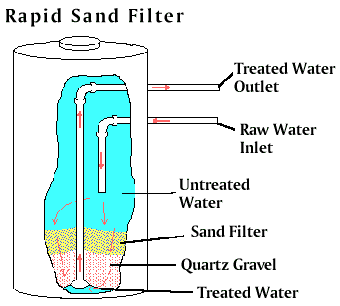The smart Trick of Industrial Water Treatment That Nobody is Discussing
Table of ContentsIndustrial Water Treatment Fundamentals ExplainedLittle Known Questions About Industrial Water Treatment.The Single Strategy To Use For Industrial Water TreatmentThe 20-Second Trick For Industrial Water TreatmentThe 10-Second Trick For Industrial Water Treatment
These include chemical rainfall, chemical disinfection, chemical oxidation, advanced oxidation, ion exchange, and chemical neutralization. Purification eliminates particles from water either by passage through a layer of sand, such as a fast gravity filter, or in a mechanical filter. Dissolved air flotation gets rid of suspended solids from the water. This is achieved by dissolving air in the water under pressure and after that launching the water/air at air pressure in a flotation tank.Sluggish sand filters use a biological process to cleanse raw water to produce potable water. They work by utilizing a complicated biological movie that grows naturally on the surface area of sand - industrial water treatment. This gelatinous biofilm called the hypogeal layer or Schmutzdecke lies in the upper few millimetres of the sand layer.
The Schmutzdecke consists of germs, fungis, protozoa, rotifera and a range of aquatic insect larvae. As the biofilm ages, more algae may establish and larger aquatic organisms including bryozoa, snails and Annelid worms might be present. As water travels through the hypogeal layer, particles of matter are trapped in the mucilaginous matrix and soluble natural material is adsorbed.
7 Simple Techniques For Industrial Water Treatment
Sluggish sand filters are generally 1 2 metres deep, and have a hydraulic loading rate of 0. 2 0. 4 cubic metres per square metre per hour. Filters lose their performance as the biofilm thickens and reduces the rate of circulation. The filter is reconditioned by removing the biofilm and a thin upper layer of sand.
Additionally wet traumatic involves stirring the sand and flushing the biolayer through for disposal. This area requires expansion. You can help by contributing to it. (likewise described as Traditional Treatment) Chemical flocculants are utilized to create a floc in the water that traps suspended solids. Chemical polyelectrolytes are used to increase coagulation of suspended solids to improve removal.

What Does Industrial Water Treatment Do?
Here the process would have either tube inhabitants or plate settlers. The water would stream up through these tubes or plates, enabling the clear water to stream over into a effluent launder, which would then carry the "settled" water to the filters for further treatment. -The tubes/plates in the settling stage, allow a higher area for the "Flocc" to settle on.
- There is typically some sort of sludge collection system that then will collect all of the settled floc aka: Sludge, and pump it or move the waste to a decant tank or basin, where it is later disposed of. -Once the settled water had actually taken a trip to the filters, and has made its method through the filters, Read Full Article it is then kept in a clearwell, where all the filtered water gets collected for additional chemical addition: pH adjuster, chlorine, ect.
Such styles might utilize solar water disinfection approaches, utilizing solar irradiation to suspend harmful waterborne bacteria directly, generally by the UV-A component of the solar spectrum, or indirectly through the existence of an oxide photocatalyst, usually supported TiO2 in its anatase or rutile stages. In spite of development in SODIS technology, military surplus water treatment units like the ERDLator are still regularly used in developing nations.
Top Guidelines Of Industrial Water Treatment

In California, more than 4% of the state's electricity intake goes towards transferring moderate quality water over fars away, treating that water to a high standard. industrial water treatment. In areas with high quality water sources which flow by gravity to the point of consumption, costs will be much lower. Much of the energy requirements remain in pumping.
Those water treatment innovations that have really low energy requirements consisting of dripping filters, sluggish sand filters, gravity aqueducts. The Safe Drinking Water Act needs the U.S. Epa (EPA) to set standards for drinking water quality in public water supply (entities that provide water for human intake to at least 25 individuals for a minimum of 60 days a year).
Industrial Water Treatment for Dummies
States may set requirements that are more strict than her comment is here the federal requirements. EPA has actually set requirements for over 90 pollutants organized into six groups: bacteria, disinfectants, disinfection by-products, inorganic chemicals, natural chemicals and radionuclides. EPA also determines and notes unregulated pollutants which might require policy. The is published every five years, and EPA is required to decide whether to control a minimum of 5 or more listed contaminants.
In the United Kingdom regulation of water products is a devolved matter to the Welsh and Scottish Parliaments and the Northern Ireland Assembly. In England and Wales there are 2 water industry regulatory authorities. (Ofwat) is the economic regulator of the water sector; it protects the interests of customers by promoting reliable competition and making sure that water business perform their statutory functions.
There is a personnel of about 240. The (DWI) provides independent assurance that the privatised water industry provides safe, tidy drinking water to customers - industrial water treatment. The DWI was established in 1990 and makes up a Chief Inspector of Drinking Water and a team of about 40 people. The current standards of water quality are defined in Statutory Instrument 2016 No.